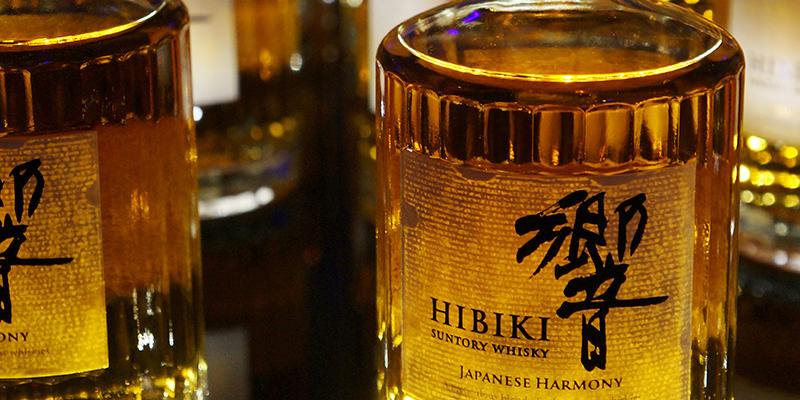Sweet, wise Bill Murray once instructed us all to “make it Suntory time.” About a decade later, we got the message.
Our apologies to Pete Venkman, but we weren’t alone. Even though whisky writers have been touting Japanese whisky for at least a couple decades now, the hype really began, as it tends to, with awards: in 2014 and 2015, the Nikka 17 Year Blended Whisky was voted “World’s Best Blended Malt” by the World Whisky Awards, and in 2015, Jim Murray’s Whisky Bible actually named a Japanese whisky—Yamazaki’s 2013 Single Malt Sherry Cask—the best in the world, declaring it a whisky “no Scotch at the moment can go near.” (Adding insult to whisky injury, Scotch whisky was entirely absent from Murray’s top five.)
Clearly, and literally, a winner, how did Japanese whisky get lost in the figurative sauce in our whiskey/whisky loving recent past? Well, for one thing, it’s hard to nail down. Originally fashioned after Scotch whisky, Japanese whisky has evolved into its own, endlessly idiosyncratic thing (we’ll get to that). And then there’s the fact that hype drives hype. After the announcement from the 2015 Whiskey Bible, the Yamazaki sold out in a number of hours. It’s like when the holidays roll around and everyone’s suddenly craving large-format poultry. Japanese whisky is the new Thanksgiving turkey. Don’t be the guy trying to buy a turkey the day before Thanksgiving. Don’t miss out on Suntory time.
Student Beats the Master
The funny thing about Japan beating out Scotland (in one ranking, anyway) is that Japanese whisky was actually inspired by Scotch (easy way to remember, Japanese whisky is spelled without the “e,” just like Scotch whisky). Chemist Masataka Taketsuru was so taken by the whiskies he encountered in Scotland in 1918 that he was determined to import the practice—not to mention a bunch of barley, peat, distillery-learned skills, and even stills—back home. (He also brought a Scottish wife. Taketsuru was not messing around.) Joining forces with Shinjiro Torii, Taketsuru founded Yamazaki, just outside Kyoto, in 1923.
As tends to happen in any joint venture, some drama crept in, since Taketsuru had originally wanted to found Yamazaki in Hokkaido (he felt the northeastern Japanese island best mimicked the Scottish climate). And this is where the great divide that created Japan’s two major whisky companies happens: Taketsuru left in 1934 to found his own distilleries, first Yoichi (in Hokkaido, win) and then Miyagikyo, which are now housed under the Nikka company. Torii, meanwhile, kept the stills running and the barley malting at Yamazaki, adding Hakushu into the mix in 1940. Blends of Yamazaki and Hakushu are bottled under the Hibiki brand, and all of them operate under Suntory.
Turning Japanese
Don’t get us wrong. Japanese whisky is made in a very similar fashion to Scotch (it kind of can’t be helped if you’re making whisky). Malted barley, peated or unpeated, distilled, possibly blended with other grain whiskies, aged in a variety of flavor-imparting vessels, bottled, possibly advertised by Bill Murray, and sold. Whisky, right? Yes. But while the spirit of production is similar, and while Japanese distilleries continued to send their talent to learn in Scotland and/or import Scottish product and equipment, a different kind of spirit evolved: the spirit of tweaking.
Think of it this way: Scotch whisky is about maintenance of regional character. An Auchentoshan 18 Year made today should taste like an Auchentoshan 18 Year made in the shiny, robotronic future. That’s also why Scotch distilleries tend to trade amongst each other. You need something a little light and heathery for your blend? Great, I could go for something a bit oilier and peated. Let’s swap. (Celebratory head butt, cheers.) Japanese whisky, with fewer binding traditions, is a determined work in progress. A Hakushu 12 Year Single Malt made this year might be improved upon by Suntory distillers, and taste different at next production.
That spirit of tweaking is also why Japanese whisky production is structurally, meticulously insular. Nikka and Suntory keep all production, and blending, in-house. That means instead of a set amount of stills creating a smaller number of distinctive blends (to be swapped and blended as needed as in Scotch), a Japanese distillery like Yamazaki has a wide variety of stills, in various shapes and sizes, all for the purposes of creating anything they need under one metaphorical roof. Add practices like using different yeast strains and “cuts” (or separations within the distillation process itself), and the possibility of picking up citrus and incense in Japanese mizunara oak in addition to, or instead of, the wide variety of whisky aging vessels, and you have the capacity for endless variety. From four distilleries. (Actually, a couple more have joined the ranks, including newcomer Chichibu in 2008.)
Which is why “Japanese whisky,” as a category, has been so hard to keep up with—and why now, we have to chase after it. Flavors span the whisky gamut, light to dark, sweet to dry, nutty to grassy, fruity to earthy, smoky to bright, a full and unexpected range of continually evolving flavors. Considering which, if you want to try some, just do a little research. Just quickly. Things go from zero to “Sold Out” about halfway down the first page on MasterofMalt.com.

